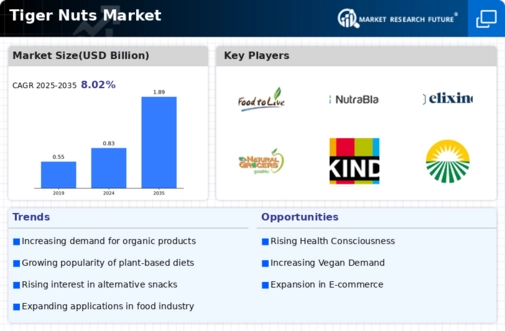Market Growth Projections
The Global Tiger Nuts Market Industry is poised for substantial growth, with projections indicating a market value of 0.83 USD Billion in 2024 and an anticipated increase to 1.89 USD Billion by 2035. This growth trajectory suggests a robust compound annual growth rate of 7.77% from 2025 to 2035, reflecting the rising consumer interest in healthy and sustainable food options. The increasing incorporation of tiger nuts into various food products, coupled with the growing demand for plant-based alternatives, positions the market for continued expansion in the coming years.
Rising Health Consciousness
The increasing awareness of health and wellness among consumers is driving the Global Tiger Nuts Market Industry. As individuals seek natural and nutritious food options, tiger nuts, known for their high fiber and nutrient content, are gaining popularity. This trend is reflected in the projected market value of 0.83 USD Billion in 2024, as consumers prioritize products that support digestive health and overall well-being. Furthermore, the shift towards plant-based diets is likely to enhance the appeal of tiger nuts, which are often used as a substitute for traditional snacks and flours, thereby expanding their market reach.
Expansion of Functional Foods
The Global Tiger Nuts Market Industry is benefiting from the growing trend of functional foods, which are designed to provide health benefits beyond basic nutrition. Tiger nuts are rich in essential nutrients, including vitamins, minerals, and antioxidants, making them an attractive option for health-conscious consumers. The market is likely to witness a compound annual growth rate of 7.77% from 2025 to 2035, as more manufacturers incorporate tiger nuts into their product lines. This expansion is indicative of a broader shift towards foods that promote health and wellness, further solidifying the position of tiger nuts in the global market.
Innovative Product Development
The Global Tiger Nuts Market Industry is witnessing a wave of innovative product development, as manufacturers explore new ways to incorporate tiger nuts into diverse food applications. From snacks to beverages, the versatility of tiger nuts allows for creative culinary uses that cater to evolving consumer preferences. This innovation is likely to attract a broader audience, contributing to the projected market growth. As companies invest in research and development to create unique tiger nut-based products, the market is expected to expand, further solidifying the role of tiger nuts in the global food landscape.
Growing Demand for Plant-Based Alternatives
The Global Tiger Nuts Market Industry is experiencing a surge in demand for plant-based alternatives, driven by the rise of veganism and vegetarianism. Tiger nuts, being a versatile and nutritious option, serve as a suitable substitute for dairy and gluten-containing products. This trend is expected to contribute to the market's growth, with projections indicating a value of 1.89 USD Billion by 2035. The increasing incorporation of tiger nuts into various food products, such as milk, flour, and snacks, aligns with consumer preferences for healthier, sustainable options, thereby enhancing their market presence.
Increased Awareness of Nutritional Benefits
The Global Tiger Nuts Market Industry is experiencing growth due to heightened awareness of the nutritional benefits associated with tiger nuts. These tubers are rich in fiber, healthy fats, and essential nutrients, appealing to a wide range of consumers. As educational campaigns and health initiatives promote the advantages of incorporating tiger nuts into diets, more individuals are likely to explore their potential. This trend is expected to drive market growth, as consumers increasingly seek out products that align with their health goals, thereby enhancing the visibility and acceptance of tiger nuts in various regions.









